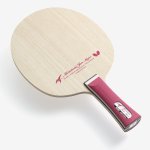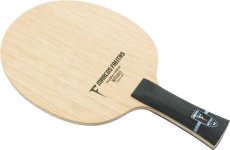This user has no status.
This user has no status.
Member
This is what Sergio thinks :
"""The theory is correct, to stop vibrations from propagating you need to have a big difference in density between materials. The resonant frequency depends on mass, if you change the mass you change the natural frequency it vibrates at. In practice, this is more of a romantic idea... There are a lot of vibration modes occurring when you strike a ball, and how the blade vibrates is dictated by the construction, materials and shape. If the vibration you are feeling is for example at the tip of your index finger, changing the handle will do absolutely nothing about it. I've made blades with low density, hollowed wood, which had virtually no vibration, but I've also made blades with solid dense wood handles that had a lot of vibration. I've also swapped from one to another on the same blade without a perceivable change in feeling.
In the case of that specific blade, the biggest reason is that it has an extremely light Ayous core. Low weight is nice and all, but it has consequences on the feeling of the blade. An inner fiber blade with 83g and a balance of 2.4cm isn't common at all, but that low density core is also less stable. If the handle pieces were completely solid then I would say that there wasn't that could be done, BUT! they are indeed slightly hollowed. I still don't think it will make a big difference, but a dense handle might help to tame some of those vibration modes."""
www.sdcttblades.com / Insta: @sdc_tt_blades
Interesting 🙂 I agree 100% with Sergio about the shape affecting vibration -- if you change the shape, you're typically changing the length and dimensions of the medium that's vibrating (remember that blades vibrate in more than one direction - energy from the impact wave radiates out in all directions at once, and the blade vibrates as the energy propagates out through the wood's material). This has cascading effects on vibration at it alters the frequencies of the waves and this in turn affects the placement and behavior of the various nodes.
I also agree that vibration is related to mass, as you can't have increased density in wood without a subsequent increase in mass.
I disagree however about the notion that changing the mass and density of the handle will do nothing about vibration in practice / application. There will definitely be a difference in vibration, as the denser handle scales are creating a localised increase in resistance to vibration. Whenever physical wave energy in one medium encounters a denser medium, energy is lost through resistance... especially with a medium such as wood, which is anything but homogenous.
I admit any change in vibration will vary depending on other factors, such as the rigidity /MoR of the wood, as rigid mediums are more prone to transmitting vibration than flexible ones, as flexible materials have more resistance to vibration. As Ayous is a hardwood, it's mass is constructed of fibers and vessels, not trachids, and the cellular walls of the fibers are long and have multiple layers -- in cross section it looks a bit like a collapsed telescope. Because of its cellular construction, it is possible for your Ayous core to have both low density, and high rigidity - in which case it's still going to vibrate a lot, despite the larger number of air pockets / voids naturally present in the wood's cellular matrix. Wood differed enormously all the time in it's physical make-up -- between species, between trees, between boards from the same tree, and between different sections of the same board. (Wood is never EVER homogeneous in it's physical make-up like metal is...it's actually far more akin to something like bone.)
Long story short, while mathematically speaking there should *always* be a change in the vibration with denser handle scales, you may not necessarily (in every single case) be able to readily feel it, or discern the changed nature of the vibration simply through touch. The perception of vibration through your sense of touch is one thing, the actual presence / amount / amplitude / frequency of vibration present in your blade is quite another.
But if it's a practical / utilitarian outcome you're after, then it's a simple thing to fix: just swap out the handle scales for something heavier and denser, and see if there's any difference. 🙂 If there is, then great -- if there isn't or if it's worse, then put the original ones back on.
===
(EDIT: I added lots of biology stuff here later on, but decided to take it out.
I really do overthink things sometimes, to a stupid degree, and I can talk too much, too often.
Apologies everyone, apologies Lodro... I'm working on the problem I promise. 🙂)
Last edited:













